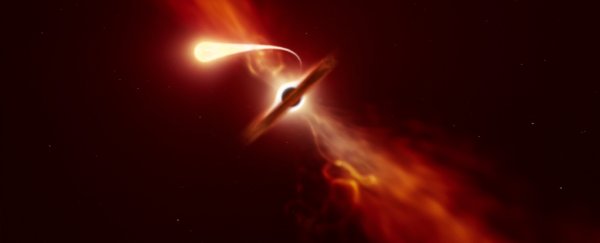From the heart of a galaxy 215 million light-years away, a brilliant flash of light flared into the void of space - the last scream of light from a dying star as it veered too close and was pulled apart by a supermassive black hole.
It's the closest such death of a star we've ever observed, offering unprecedented insight into the violent cosmic process.
Although catching a stellar death-by-black-hole is uncommon, astronomers have observed enough by now to figure out the broad strokes of how it happens. When a star ventures too close, the immense tidal force of the black hole - the product of its gravitational field - first stretches and then pulls the star so hard that it's torn apart.
This tidal disruption event (TDE) releases a brilliant flare of light before the debris of the disintegrated star disappears beyond the black hole's event horizon. But that flare of light is often at least partially obscured by a cloud of dust, which makes studying the finer details difficult.
The new TDE, first spotted in September of last year and named AT2019qiz, is now helping a team led by astronomer Matt Nicholl of the University of Birmingham in the UK shed light on the origin of this dust.
"We found that, when a black hole devours a star, it can launch a powerful blast of material outwards that obstructs our view," said astronomer Samantha Oates of the University of Birmingham in the UK.
Stellar TDEs are one of those cosmic phenomena that are impossible to predict - you just have to keep surveying the sky and wait for the tell-tale flare. This is what happened with AT2019qiz, and astronomers were quick to turn their telescopes to a small patch of sky in the constellation of Eridanus, and the heart of a spiral galaxy 215 million light-years away.
"Several sky surveys discovered emission from the new tidal disruption event very quickly after the star was ripped apart," said astronomer Thomas Wevers, who was at the University of Cambridge in the UK during the research.
"We immediately pointed a suite of ground-based and space telescopes in that direction to see how the light was produced."
As the star is torn apart, some of the resulting debris spaghettifies, attenuating into a long, thin thread of material that feeds into the black hole.
The flare is the result of intense gravitational and frictional influences in this accreting material. These influences heat the material to such high temperatures that the TDE can briefly outshine the host galaxy.
From that initial flare, the TDE fades over a period of months. Nicholl and his team observed and carefully plotted the fading of AT2019qiz across multiple wavelengths of light, including ultraviolet, radio, optical and X-ray. This was another stroke of luck - TDEs mostly glow in optical and ultraviolet.
This light allowed the team to calculate the masses involved in the AT2019qiz.
"The observations showed that the star had roughly the same mass as our own Sun, and that it lost about half of that to the black hole, which is over a million times more massive," Nicholl said.
Between the rapidity with which the team turned their attention to the event, its close proximity, and the broader-than-usual spectrum across which they observed it, they also determined that the obscuring dust was part and parcel of the TDE, and not a separate phenomenon.
"AT2019qiz is the nearest tidal disruption event discovered to date, and hence, incredibly well-observed across the electromagnetic spectrum. This is the first case in which we see direct evidence for outflowing gas during the disruption and accretion process that explains both the optical and radio emissions we've seen in the past," said astronomer Edo Berger of the Harvard-Smithsonian Center for Astrophysics.
"Until now, the nature of these emissions has been heavily debated, but here we see that the two regimes are connected through a single process. This event is teaching us about the detailed physical processes of accretion and mass ejection from supermassive black holes."
The research is just the most recent breakthrough in studying TDEs.
Earlier this year, a team confirmed that some of the debris from the disrupted star swirls into a disc of material that feeds into the black hole, like water down a drain. A TDE a few years earlier revealed that the jet of plasma launched by the black hole is proportional to how much of the star it devours. And a star that escaped total disruption shows that a black hole can ration its meal, and feed off an orbiting companion for billions of years.
But AT2019qiz, the researchers say, is a special case that will continue to aid our efforts to understand these incredible events.
"The exquisite data presented here," they wrote in their paper, "will make AT2019qiz a Rosetta stone for interpreting future TDE observations in the era of large samples expected from Zwicky Transient Facility, the Rubin Observatory and other new and ongoing time-domain surveys."
The research has been published in the Monthly Notices of the Royal Astronomical Society.
